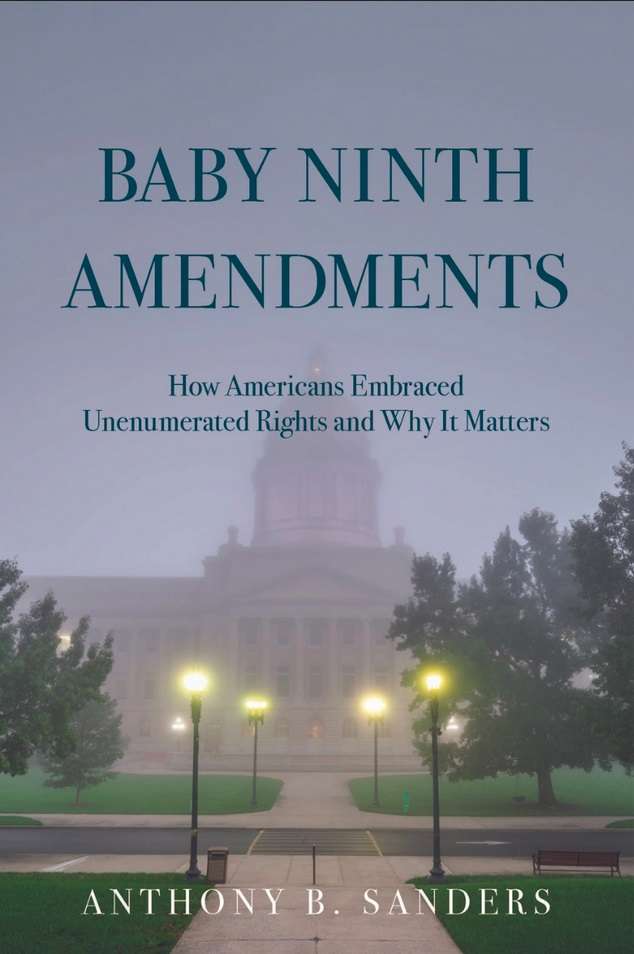Yesterday I started these Baby Ninths posts (summarizing my new book, from University of Michigan Press, Baby Ninth Amendments: How Americans Embraced Unenumerated Rights and Why It Matters–available for free here) with a thought experiment about why we might want an “etcetera clause.” Today we’re going to take a quick overview of the history of that kind of clause in state constitutions. It was a slow, but steady, process where various groups of Americans repeatedly solved the same problem our friend Jane encountered: How do we protect the infinite possible exercises of our liberty with a finite constitution?
In the beginning there were no unenumerated constitutional rights. And that’s because there were no constitutional rights, period. Excuse me, I should have said full stop. Because I’m speaking of the British Constitution. As discussed on a recent podcast I hosted, the British Constitution is a thing that exists, but it’s not written down in one place. And in some respects it’s simply the sovereignty of the “King in Parliament.” At times in their history the British have speculated there might be “rights” that even Parliament cannot abridge (most famously some musings from Lord Coke), but that had essentially died out long before the American Revolution. In their revolutionary fever, however, Americans mused anew, threw off the sovereignty of Parliament, and adopted “the people” as sovereign. And this “people” acted through adopting written constitutions that were a “higher law” than the legislature. And a neat thing about a written constitution is you can put “rights” in it that the legislature cannot abridge.
The first full-fledged bill of rights was Virginia’s Declaration of Rights, which George Mason drafted in the spring of 1776. It had many enumerated rights we’d be familiar with, but also some pretty broad language, such as “the enjoyment of life and liberty” and “pursuing and obtaining happiness and safety.” The provision was later copied in numerous other state constitutions.
Were they “etcetera clauses”? If not they’re pretty close. Steve Calabresi calls them “Lockean Natural Rights Guarantees,” which seems a pretty good description to me. (For their story check out an article he co-authored.)
Then came Philadelphia in 1787 and all that. And shortly thereafter the amendments we now call the Bill of Rights. There’s not space here for the story of the Ninth Amendment itself. As I said yesterday, some people, like Randy Barnett, think it means what it says and protects rights beyond those enumerated. Some, like Kurt Lash, think it’s basically about federalism. There are other takes too that I summarize in the book.
Whoever is right about the Ninth—my book is Switzerland when it comes to interpreting the Ninth Amendment itself—it’s definitely true that it was new. There’s no example of its language in use in any document before 1789. Afterward is a different story.
Today, no U.S. state has adopted a new constitution since Rhode Island did in 1986. That’s super weird in U.S. history. States used to hold conventions and adopt new constitutions all the time. The years after 1789 were no exception. Many states adopted constitutions in the 30 years after the Ninth Amendment was drafted. They put all kinds of things in their bills of rights, including Lockean Guarantees. For whatever reason, none included Ninth Amendment language—although a few adopted what I call “Baby Tenth Amendments.”
Then, in July 1819, the almost-state of Alabama was holding a constitutional convention. Its bill of rights committee was tasked with drafting something up. And after a week of work out emerged a list of rights with these words as part of the last provision: “This enumeration of certain rights shall not be construed to deny or disparage others retained by the people . . .”
Hmm, that looks kind of familiar, doesn’t it? Why did the committee put it in there, and who specifically suggested it? Alas, I’ve never found anything in a dusty or digital archive definitively telling us why. In any case, although other provisions were fiddled with in the full convention this one stayed in as is. Whatever the delegates’ subjective reasons were, it then became part of Alabama’s first constitution. (I don’t think it matters that much for future interpretation, especially outside of Alabama, because I’m an original public meaning originalist, something I talk a bit about in the book. But it still would be neat to know.)
Then, three months later, Maine was holding a constitutional convention to help seal its emancipation from Massachusetts. And, in similar unrecorded fashion, its bill of rights committee had this at the end of its draft: “The enumeration of certain rights shall not impair nor deny others retained by the people.” It then became part of the Maine Constitution, which is still in force today. (By the way, notice the lack of “construed” and the swapping of “impair” for “disparage”? A handful of states dispense with the “construed” language and many include “impair” instead of, or in addition to, “disparage.”)
After that—despite a number of constitutional conventions in various states—it wasn’t until 1836 that a state adopted another Baby Ninth, in Arkansas. But then a few more came along, including states that were on their second constitution: Maryland, New Jersey, and Ohio. By the eve of the Civil War a dozen states had adopted one.
Reconstruction accelerated this trend. A couple states dropped Baby Ninths in the whirlwind of constitution-making in the years after the war, but more adopted them. And those states that dropped them added them back in at the next convention a few years later. Then, with westward expansion, the popularity of Baby Ninths accelerated even more. Indeed, of all fifteen states added to the Union since West Virginia in 1863 the only ones to not include a Baby Ninth are North and South Dakota. (Why them? I don’t speculate in the book but I’m currently working on a paper to see if I can figure that out.)
It’s not all wine and roses for Baby Ninths, as South Carolina dropped its in 1895 and Missouri did in 1945. But those are more than countered by other states adopting them. The latest two are Michigan in 1963 and Illinois in 1970. As of now thirty-three states—two thirds of the Union—have language extremely similar to the Ninth Amendment in their higher law.
What did the delegates who adopted these provisions think of them? Luckily some states kept better records than 1819 Alabama and Maine. We’ll turn to that in Part III. We’ll also look at what state courts have thought of them. The tl;dr is the delegates thought they protected individual rights. The courts’ verdicts are more mixed, but it’s mostly a story of neglect. Courts have left Baby Ninths lonely despite their language sitting there waiting to be used to protect rights “retained by the people.” There are a fair number of cases where courts have found laws to violate individual rights via a Baby Ninth. But often the laws are upheld under a kind of rational basis review. And even when state courts do protect unenumerated rights via state constitutions it’s through more ill-suited provisions, such as due process clauses.
The post Baby Ninth Amendments Part II: The Invention of Unenumerated Rights appeared first on Reason.com.





